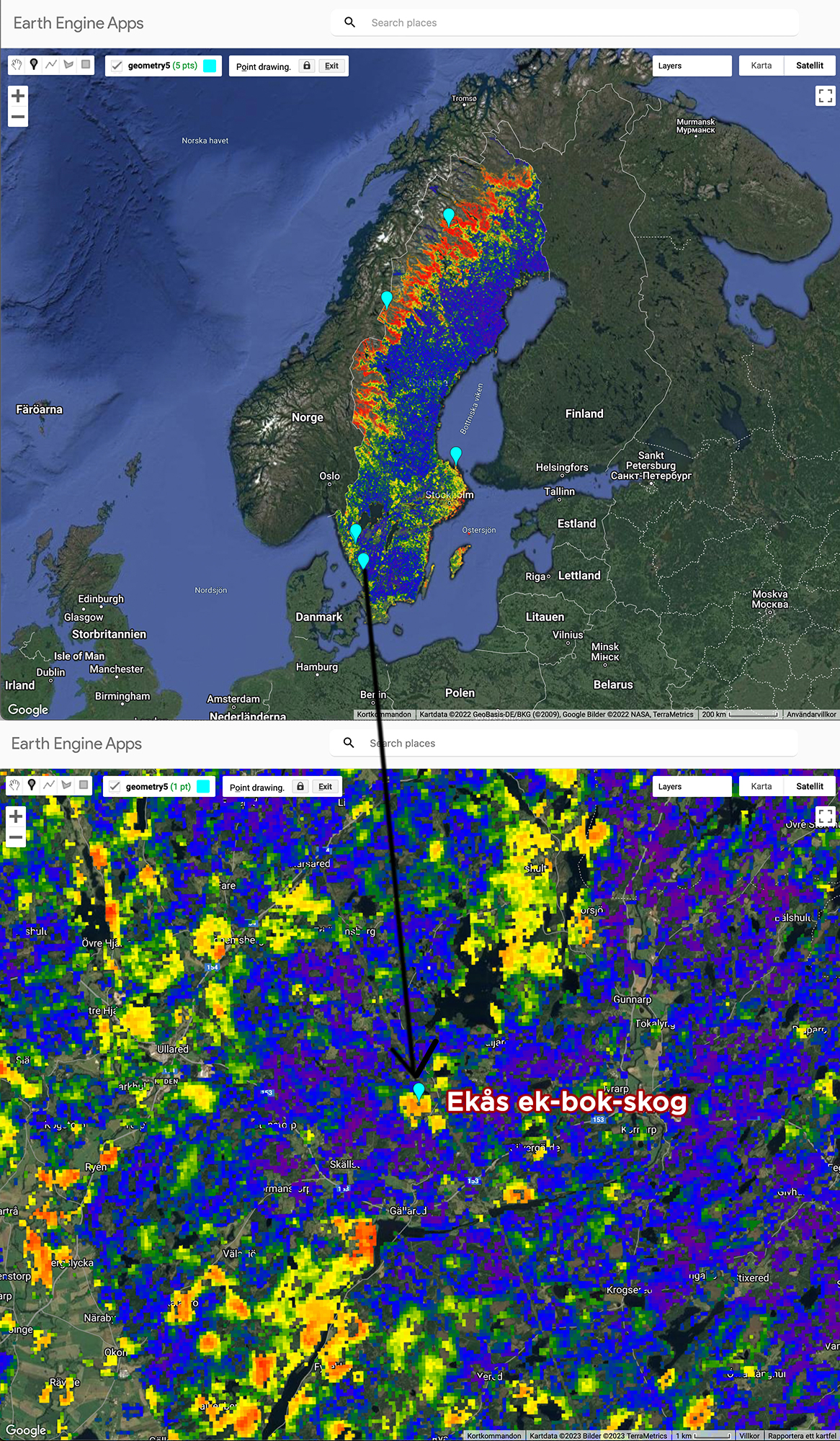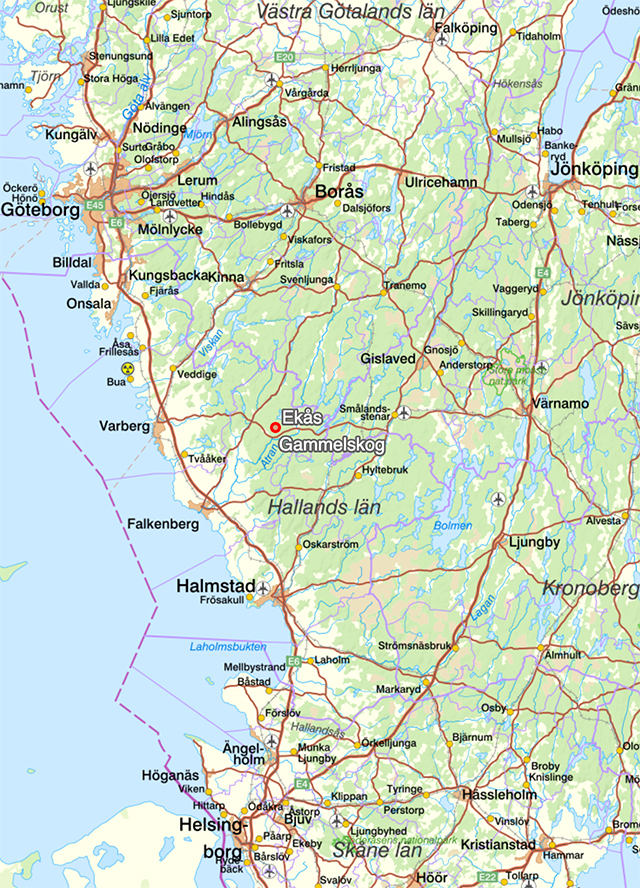Ekås oak-beech forest
The property - (click here to show hide)
Naturarvet signed a contract on Ekås oak-beech forest in Gällared parish in Falkenberg municipality, Halland, in September 2023 and is awaiting a decision on land registration. The 25 ha property is located at about 150 m above sea level and is well connected with a small part of Stora tjärnet in the north and good accessibility via public roads and a common road passing through the southern part.
17 ha of the area is older deciduous forest, and is a small secondary remnant of the previously dominant deciduous oak and beech forest that is typical of the nemoral zone in southern Sweden. Throughout the property there are traces of the agricultural landscape, which has largely been cultivated arable land and pastures. Stone fences, stone cairns, old roads, a flax bank and other structures are reminders of past times, where nature has now reclaimed the land.
We are humbly grateful that this property was for sale and that we had previously received several substantial gifts that made it possible to acquire the property.
Nature - (click here to show hide)

The increasing amount of dead standing and lying wood, the growing number of old trees and the varying nutrient content of the soil give the forest a good range of species and tree populations. Particularly important environments include: 1. mixed oak forest with elements of hazel groves and other deciduous trees such as ash, lime and maple; 2. open pastures that have been managed with grazing for a long time, as well as parts of the oak forest; 3. natural beech forest with clear traces of previous grazing and arable farming through remnants of fences and cairns, and here and there oaks that are pushed back by the beech trees; 4. open marshland and swamp forest areas that can develop into fine natural values after some restoration of the wetland; 5. older mixed spruce forest by the lake, with an original province of spruces.
No previous documentation of species existed on the property and Naturarvets GM and administrators from the County Administrative Board of Halland County have made an inventory of species during the summer and fall of 2023. Here is a selection of species found:
- Greater butterfly orchid Platanthera chlorantha Signal species
- Small-leaved lime Tilia cordata LC
- Ash Fraxinus excelsior EN
- Red fox Vulpes vulpes LC
- Common swift Apus apusEN
- Green woodpecker Picus viridis LC
- Black woodpecker Dryocopus martiusNT
- House Martin Delichon urbicum VU
- Wren Troglodytes troglodytes LC
- Nuthatch Sitta europaea LC
- Sneaky fly agaric Armanita phalloides Signal species
- Western hook moss Rhytidiadelphus loreus Signal species
Climate - (click here to show/hide)
In this deciduous forest in southwestern Sweden, the carbon sequestration is about 20% higher than the effective carbon sequestration in e.g. Fågelskärsudden. Fågelskärsuddens old-growth forest on Gräsö in north-eastern Uppland. The soil is slightly richer than the average for Sweden and where carbon storage is most effective it is important to protect it.
As a secondary forest, Ekås oak-beech forest has good growth that will continue for several hundred years. Forestry plans drawn up in connection with the sale of Ekås oak-beech forest provide a good picture of how much area is now preserved from felling and thinning and how much CO2 can be sequestered in the different parts of the forest in the future.
Protecting Ekås oak-beech forest and other similar ancient forests is the most important action we can take locally to slow down climate change globally.
The collection
To the Fundraising pageIn September 2023, a contract was signed and a deposit paid. Through record fundraising in 2022 and strong fundraising in the spring of 2023, including advances from corporate sponsorship, we had already raised part of the purchase price. Land registration is underway, as the forest is to be subdivided from an older farm property, and Naturarvet is expected to gain access to the subdivided property in early 2024. Join us and contribute to the protection of Ekås oak-beech forest and that more forests can be acquired in 2024.
How to get here - (click here to show/hide)
Ekås oak-beech forest is located about 150 meters above sea level in Gällareds parish in the eastern part of Falkenberg municipality, Halland. The nearest town is Ullared about 7 km by car. Ekås oak-beech forest can be reached via the public road network and a common road that passes through the southern part of the property. Parking will be provided along the common road and a path will be marked to visit the forest without disturbing neighbors. By public transport you can get from Ullared in the west or Ätran in the east with bus line 558 to Gällared church. Plan your trip on the Länstrafiken website here. From Gällared you can walk 3.5 km or cycle 4 km to Ekås.
If you come by car, you can park by the road at approximately these coordinates 57.120288, 12.832760 and from there walk up into the forest north of the road and east of the right-of-way or south of the road on both sides of the right-of-way.Remember to respect the right of public access and not to disturb the privacy of residents and vacationers in the area. Do not park or walk on private roads and land. Some of the forest and the open pastures are grazed during part of the summer. Do not damage fences and close any open fence entrances behind you. Avoid walking in grazed areas during the grazing period if you are afraid of cattle.
